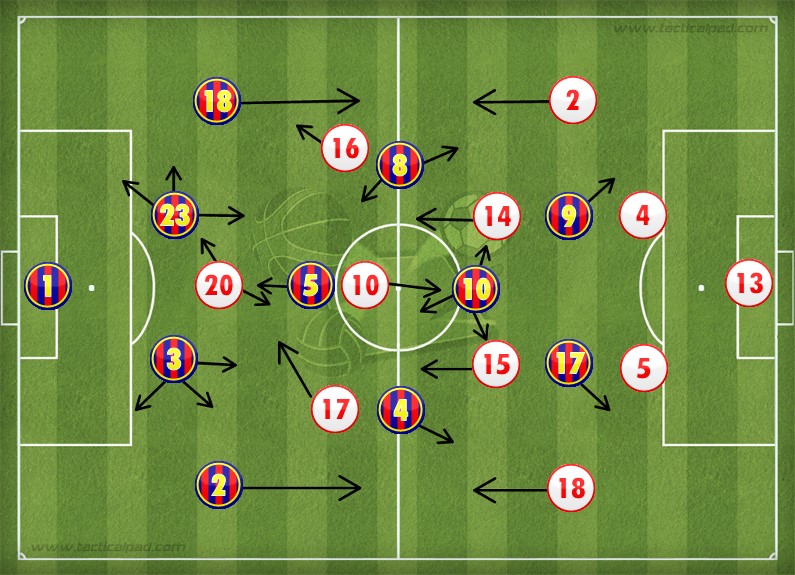The Europa League final was played in Warsaw, where FC Dnipro Dnipropetrovsk from Ukraine, were up against last year’s Europa League winners Sevilla, in a game that offered great drama. Dnipro, who knocked out many of the big teams in the tournament, could not have had a better start to the match, when Kalinic found the back of the net early on with a header. Sevilla managed to turn the game around in their favor and make it 2-1, before Dnipro found time to level the score to 2-2, thanks to a beautiful free kick goal by Rotan just before the 1st half ended. The clinical Colombian striker, Bacca was, perhaps predictably, the hero for Sevilla (he was also named the man of the match). It was through his two goals that Sevilla can now lay claim to their second Europa League title in a row.
Line ups
Dnipro: 71 Boyko, 12 Leo Matos, 14 Cheberyachko, 23 Douglas, 44 Fedetskiy, 7 Kavanka, 29 Rotan,Fedorchuk 25, 10 Konolopyanka, 99 Mateus, 9 Kalinic
Sevilla: 29 Sergio Rico, 6 Carrico, 15 Kolodzieczak, 2 Tremoulinas, 22 Aleix Vidal, 4 Krychowiak, 22 Mbia, 19 Banega, 20 Vitolo, 10 Reyes, 9 Bacca
Goals: Kalinic, Rotan // Krychowiak, Bacca x2
Dnipro in defence
What many may ask themselves is: how did Dnipro make it all the way to a Europa League final.
The answer to this question can actually be found by studying Markevich’s tactical style and understand how incredibly organized Dnipro is in defence. To get a better insight of the team’s tactical organization and to also understand why other teams have found it hard against Dnipro, we simply have to go into detail, and look at how easily they can shift between different systems and formations during a match, and that too in a really organized way.
In this game against Sevilla, Dnipro started with a 4-1-4-1 formation with a zonal-defending + man-marking (wingers and fullbacks) scheme. Dnipro proved how flexible they could be while using this system as they were able to shift, depending on the opponent and the ball’s position in various situations, for example: moving up the defensive-midfielder (Kavanka) to form a straight midfield line of four men, where one of the wingers or central-midfielder puts pressure on the opposition player in possession of the ball.
Here you see an example of when Kavanka (marked in yellow) did maintain his “normal” position, in the zone between the defending & midfield-line. Kavanka’s mission was to try and block the play through the half-spaces of Sevilla, who were trying to find Vitolo/Reyes and Bacca. And, if the ball was to be played through the 4-man midfield-line of Dnipro, then Kavanka was supposed to be the one blocking the attack of Sevilla/recovering the ball for Dnipro.
In a situation like this, Rotan was the one to put pressure on M’bia to try and force Sevilla to play it long.
Whenever one of the central midfielders or wingers started to press, Dnipro switched and formed a flat 4-man midfield-line, as seen in the picture above. Here you can see that Kavanka left his defensive-midfielder position positioning himself a bit higher with the remaining 3 players in midfield to create the 4-man midfield. Now Rotan could put the pressure on the player in possession without worrying of leaving a gap/space for Sevilla to exploit. This did create a two 4-man defending-lines of Dnipro, which made it harder for Sevilla to play through. Good compact defensive organization both vertically and centrally. (Notice the position of M’bia, who was in this game positioned very deep but more on that later).
The Sevilla build-up play
The build-up play from Sevilla was something that we see quite often nowadays in modern football. Sevilla started their build-up with Krychowiak (defensive-midfielder) dropping deep in between the 2 center-backs, creating a 3-man defense which ultimately gave the full-backs space to position themselves in a more attacking wide position. Now giving the full-backs of Sevilla (Tremoulinas and Aleix Vidal) such freedom to penetrate into attacking areas in the flanks opened up opportunities for the wingers of Sevilla to penetrate the half-spaces (in the spaces to the left and right of Kavanka). Basically meaning that Sevilla played with ‘’false-wingers’’ as Reyes and Vitolo were often seen in these areas, and not in the typical wingers positions.
In this situation we can see the tactical organization of Sevilla’s build-up. Notice the 3-man defensive line with Krychowiak in between Carrico and Kolodzieczak. The players marked in blue are the 2 central midfielders of Sevilla (Banega and M’bia). Notice also how deep down M’bia and Banega are positioned to try and get the ball in an area of the pitch where they have more space and time with the ball. Now the yellow-marked players are the full-backs of Sevilla which shows you exactly how wide and attacking minded they were in this game.
In the situation above, Dnipro is starting to move/position the different parts of the team deeper in their own defensive half as Dnipro attacked a lot and most of the times through the skillful wingers: Konoplyanka and Matheus, with fast transitions from defense to attack.
Because of the deep defending Dnipro, Sevilla had their two central midfielders (Krychowiak the 3rd one positioning himself as a centre-back) dropping deep to have more space and time on the ball to try and play through the compacted midfield-line of Dnipro. Notice how M’bia in this game was seen penetrating a bit more to the right side of the central-area as he created the balance/back-up to the space that Aleix-Vidal left. This allowed Sevilla to prevent Dnipro from making counter-attacks through Konoplyanka’s side, which helped Sevilla create a balance and not exploit themselves in defence.
Here you can see, again the 3-man defense and the deep-positions of Banega and M’bia in the build-up, and the combination of Vidal and Tremoulinas penetrating the flanks. The positions of Vitolo and Reyes (the players marked in white) whom as you see are positioned almost as 2 extra central-midfielders (#10). This shows how Sevilla used their wingers as ‘’false-wingers’’ and how they tried to occupy/penetrate in the spaces between the 2 different defensive lines of Dnipro.
Here is another example of the build-up and the positions of Banega and M’bia. Here we see how Banega has dropped deep to an area where he can receive the ball with more time and space than in the central areas of the pitch. This position of Banega occupies 3 players of Dnipro, which eventually leads to a situation where Banega has no player putting pressure on him, and can also turn with his body shape towards the opposition goal with the ball in possession.
Banega receives the pass from Krychowiak and by positioning himself deeper, he was able/given space and time to turn and start penetrating with the ball towards the Dnipro goal. Notice the positions of Vidal keeping the width and Reyes+Vitolo as the number 10’s.
Banega plays the ball to Reyes who just before receiving the pass, leaves his zone/space behind Rotan, to eventually get the ball in the space in front of Rotan (a move which makes him hard to mark).
Now when receiving this pass, Reyes, thanks to this move is given space and time to be able to turn with the ball and start rushing towards the midfielder. This movement of Reyes forces Kavanka to leave his position to help Rotan, which in turn leaves a massive gap in the half-space for Vitolo and Bacca. The run of Bacca is an intelligent one as he notices the amount of space that Sevilla now has, behind the Dnipro defence.
Reyes reads the run of Bacca well, and plays a perfect “through-ball” to Bacca. A through-ball that has taken out the entire midfield and defense of Dnipro, leaving Bacca 1-on-1 with the keeper, and he went on to score the 2-1 goal for Sevilla.
This situation explains how Sevilla try to use their two wingers much more centrally as you see how Reyes here has the freedom to for example play a through ball in a deep-central area of the pitch, but also the freedom of Banega to move freely trying to find attractive spaces for him to find these kind of magnificent through-balls. This is also often and already seen at the Barcelona attacking style of play as Neymar and Messi penetrates the half-space areas much more than the usual winger’s position.
Conclusion
Ever Banega has really found himself the right position and attitude, proving his real worth and exceptional talent. With the flexibility of the different attacking approaches through the use of Ever Banega and the wingers, Sevilla are able to switch from a direct-type and possession based attack during a game, making the team less predictable.
One of the key features of this Sevilla side is the exceptional use of Banega that Emery has implanted, but also the way that they are able to counter-press the teams when in loss of possession of the ball, especially the counter-attacks through the flanks. Sevilla has also a great way of out-numbering and inviting the opposition to pressing-traps as they are also able to win the ball back fast, with plenty of energy and an aggressive approach.
It would also seem apt to appreciate the fantastic season of Dnipro who have provided a fantastic Europa League campaign this season, but more importantly to Sevilla for the victory of the Europa League, but also automatic qualification for the UEFA Champions League, making them the 5th (historical) Spanish side to qualify for next season’s edition of the tournament.
Written by Albin Sheqiri
- Antonio Conte: Exploring Italy’s tactics at Euro 2016 - July 22, 2016
- Analysis: The genius of Lionel Messi | Offensive Pressing Traps, La Pausa and more - January 21, 2016
- Tactical Analysis: Roma 1-1 Barcelona | Busquets man marked and battle of the center - September 22, 2015

































































